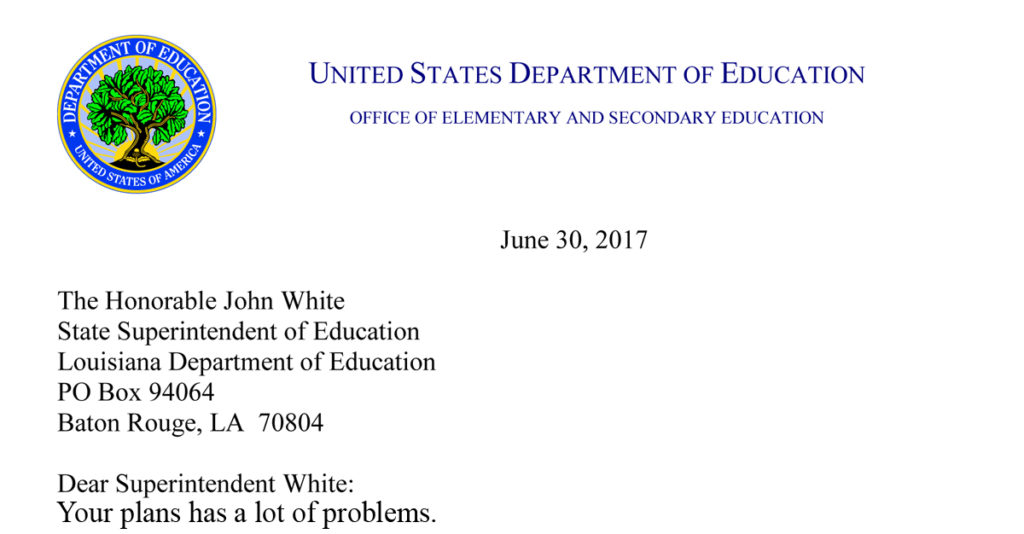Louisiana’s Educational Facade

On June 26th, The Advocate published its article, State Plan to Revamp Public Schools Wins Compliments from Two Groups, giving praise to Louisiana’s new ESSA plan which was submitted to the U.S. Department of Education on May 3, 2017. The State’s plan has received accolades from national groups for its “ambitious goals” to improve public education in Louisiana. The two groups mentioned in this particular article are the Collaborative for Student Success (CFSS) and Bellwether Education Partners (BEP).
 I was not at all surprised to see these organizations offering their credibility to support Louisiana’s ESSA plan; nor, was I impressed. These organizations exist because they are part of the very large network of nonprofit organizations that have been established through the collaborative philanthropic efforts of billionaires to provide credibility to education reform efforts. A quick visit to the CFSS website reveals who funds their efforts, and you may remember the blog I did in October 2016 on Bellwether Education Partners. I could go on and on about the endless efforts and bottomless pockets of the nonprofit network, but that really isn’t the focus of this blog. What I want to take a look at is the feedback letter that the U.S. Department of Education sent to Supt. John White on June 30th, along with the notes from the peer reviews conducted at the USDOE.
I was not at all surprised to see these organizations offering their credibility to support Louisiana’s ESSA plan; nor, was I impressed. These organizations exist because they are part of the very large network of nonprofit organizations that have been established through the collaborative philanthropic efforts of billionaires to provide credibility to education reform efforts. A quick visit to the CFSS website reveals who funds their efforts, and you may remember the blog I did in October 2016 on Bellwether Education Partners. I could go on and on about the endless efforts and bottomless pockets of the nonprofit network, but that really isn’t the focus of this blog. What I want to take a look at is the feedback letter that the U.S. Department of Education sent to Supt. John White on June 30th, along with the notes from the peer reviews conducted at the USDOE.
In its feedback letter, the USDOE expresses several areas of concern related to the plan that was submitted in May and allows the Louisiana Department of Education a very limited 15 days to revise and resubmit. The areas addressed are too many to cover in one writing, so I just want to focus on the ones that are not only contrary to the praise received from CFSS and BEP, but were also opposed by numerous groups considered to be stakeholders in the Louisiana education system which includes association representing school boards, superintendents, principals, teachers and parents.
ACADEMIC ACHIEVEMENT INDICATOR
In the new ESSA law, it is carefully spelled out what should be used to measure academic achievement, and USDOE expresses it concern with Section A.4.iv.a: Academic Achievement Indicator and says this:
In the new ESSA law, it is carefully spelled out what should be used to measure academic achievement, and USDOE expresses it concern with Section A.4.iv.a: Academic Achievement Indicator and says this:
“In its State Plan, LDE includes, within the Academic Achievement indicator, student
achievement on reading/language arts, mathematics, science, and social studies assessments.
For the Academic Achievement indicator required under ESEA section 1111(c)(4)(B)(i)(I), a
State may only include measures of proficiency on the annual assessments required under
ESEA section 1111(b)(2)(B)(v)(I) (i.e., reading/language arts and mathematics); a State may
include performance on assessments other than those required under ESEA section
1111(b)(2)(B)(v)(I) (e.g., science, social studies) in the indicator for public elementary and
secondary schools that are not high schools as required under ESEA section 1111(c)(4)(B)(ii)
(i.e., the Other Academic indicator) for elementary and secondary schools that are not high
schools or in the School Quality or Student Success indicator for any schools, including high
schools.”
What this section addresses, in layman’s terms, is one of the main concerns that was expressed by the State’s education groups regarding testing in all subjects. As stated in the sections referenced above, ESSA allows for academic achievement to be Louisiana’s Educational Facade – Educate Louisiana:

